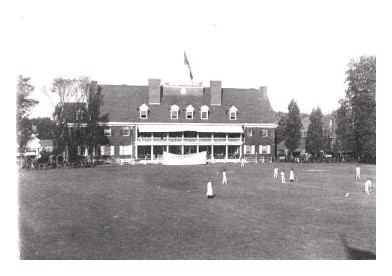The Germantown Cricket Club
411 Manheim Street
Philadelphia, PA 19144
United States
Germantown Cricket Club- Manheim
Germantown Cricket Club- Manheim

Playing cricket was popular in mid-nineteenth century America, and Philadelphia was the center of the craze. After observing the game being played by English immigrant millworkers in Germantown, college students formed teams at Haverford in 1833 and at the University of Pennsylvania in 1842.
The catalyzing agent at Penn was William Rotch Wister (1827-1911). Called the “Father of American Cricket,” he went on to play a role in founding both the Philadelphia and Germantown Cricket Clubs in 1854. By the time of the Civil War, at least thirty clubs were playing in the city.
The Germantown club played on various estates in its first decades, but they only built permanent facilities following their 1889 merger with the archrival Young America Cricket Club. With a combined membership of 2000, they now acquired the Littell and Price estates on Manheim Street with the intention of building a clubhouse and cricket pitch. The club would be called “Manheim” because of the address.
The rising firm of McKim, Mead, and White was hired to plan the new facilities, and Charles Follen McKim (1847-1909) was put in charge. As a teenager living on Wister Street in Germantown in the 1860s, he had played cricket with the Young America club, but he left Philadelphia in 1866 to attend Harvard (where he was vice president of the cricket club) and then the Ecole des Beaux-Arts in Paris.
When he returned to Germantown in 1889, McKim designed a main clubhouse that signaled that he and his partners, who had made their reputation designing picturesque houses, were beginning to steer in a more formal, classical direction. But whereas their Boston Public Library (1888-1895) and Low Library at Columbia University (1895-1897) would be grandly Renaissance and Roman in style, for the cricket club McKim adopted the gentler classicism of eighteenth-century England—and its American colonies. With its reddish brown brick and bright white wooden trim, it is an early example of the “Colonial Revival.”
The main block of the clubhouse, opened in October 1891, is organized like a large house, with the main entrance on the on the northeast front and a two-story porch recessed into the southwest façade. The latter offered a shady vantage from which to view action on the grass pitches, which McKim laid out at the same time. A grandstand, now demolished, faced the main building. The gabled wings at the ends were added in 1902 and 1907. Dining and sitting rooms fill the ground floor, while most of the second floor is devoted to a large ballroom, with a stage at one end.
Also designed by McKim, Mead, and White was the porticoed Athletic Building of 1901. It contains locker rooms, squash courts, bowling alley, and swimming pool.
The opening in 1891 was marked by a gala ball in honor of an English team of cricketers, led by Lord Hawke (Martin Bladen Hawke). 40,000 people watched six days of play between the visitors and their hosts.
Tennis gained ascendancy over cricket at Germantown early in the twentieth century. Grass tennis courts were laid out on the cricket pitch, land for more courts was purchased, and by 1911 there were twenty dirt courts as well. In 1921 it was decided that cricket should be played only when it did not interfere with tennis
The apogee of the club's tennis fame came during the career of William "Big Bill" Tilden (1893-1953), who played for Germantown and whose family lived near the club. Tilden dominated world tennis in 1920-1925. He was the first American man to win the Wimbledon title, in 1920, and he repeated that success the next year. With William M.
Johnston, he won the Davis Cup back from Australia in 1920. The National Tennis Tournament was awarded to Germantown for the first time in 1921, and Germantown hosted the matches again in 1922, in addition to the Davis Cup. In 1920-1925, Tilden won six United States singles championships in succession, and those in 1921-1923 were won at Germantown. The Davis Cup matches in 1924-1927 were played at Germantown as well.